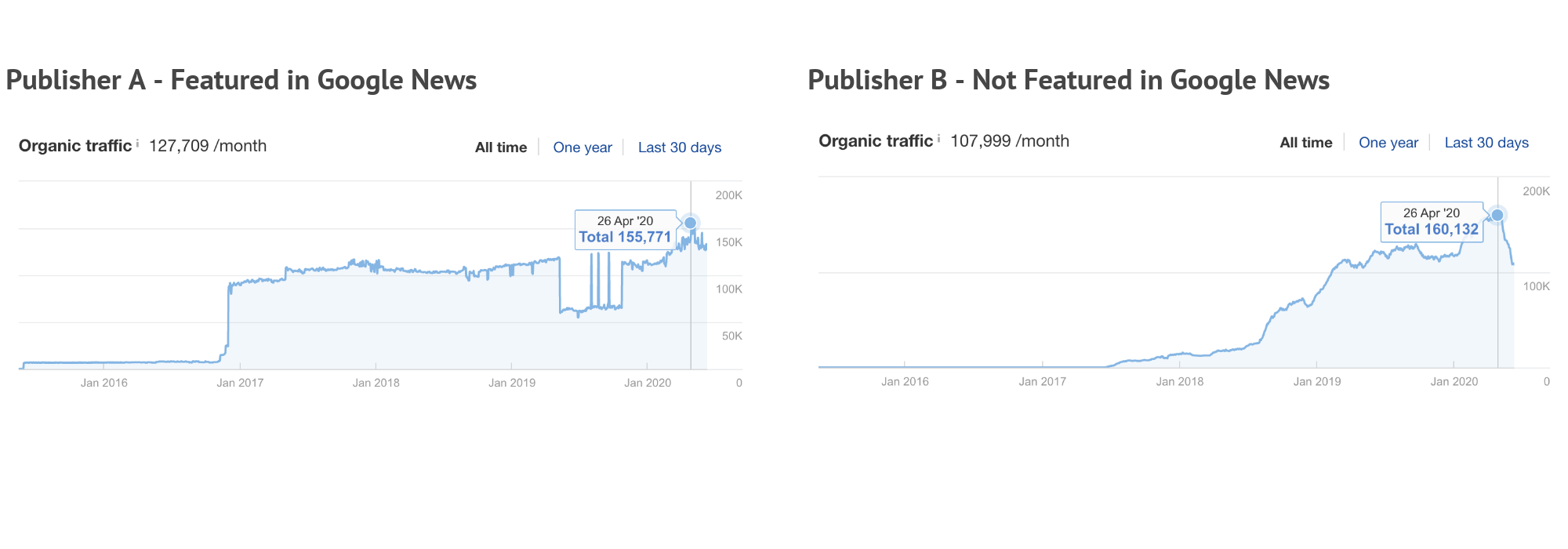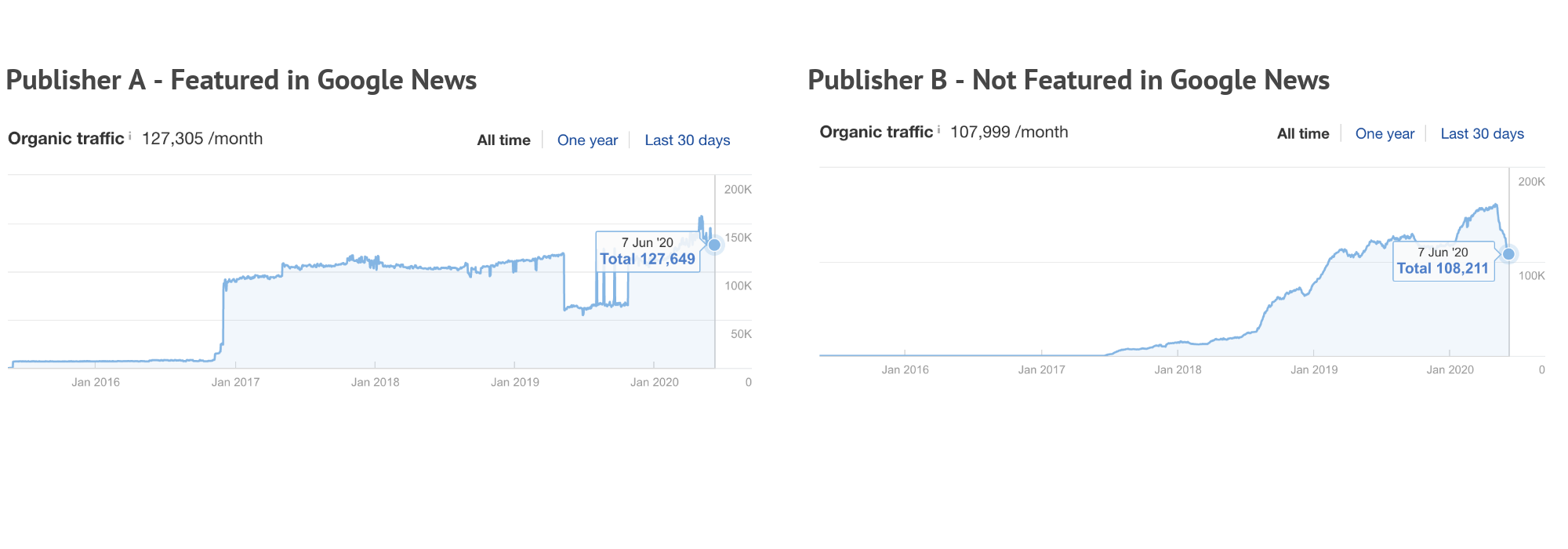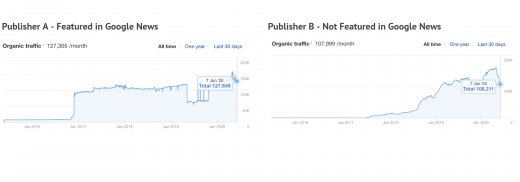How Can Publishers Grow Traffic After the Latest Google Update?
How Can Publishers Grow Traffic After the Latest Google Update?

*Mentioned products, tools in the article are non-affiliated and non-sponsored.
After Google announced its latest core update on May 4th, more and more publishers have faced a significant drop in their traffic. Having armed with key data and metrics, I would like to share with you four major tips on how to recover from this traffic crack.
1. Get your blog featured in Google News
According to SimilarWeb.com Google News currently has over 500M monthly visits. As it is the dream of most online publishers to reach an audience this big, this is the chance to distribute your content to a readership that is already well-established.
The potential of Google News is incredible and can help you to become one of the most featured blogs in your industry.
Let’s compare Ahref’s results on how organic traffic has changed from April to June for two Setupad publishers -– Publisher A and Publisher B.
Publisher’s A website is dedicated to the news category and displayed in Google News.
On the other hand, Publisher’s B website is about recipes and food and is not featured in Google News.
According to the figure below, on April 26th, organic traffic was greater for Publisher B. The Publisher B results could lead us to think that after Google’s latest update, Publisher B would see a heavier drop in organic traffic in comparison to a Publisher A, who is in Google News.

The figure below shows that both publishers experienced a drop in organic traffic after the latest Google Update. However, for Publisher A, organic traffic decreased only by 28K, while Publisher B experienced a drop over 51K in organic traffic.

What should you keep in mind?
- Your content has to be optimized for search engines, so make sure you are running SEO.
- Google News SEO can help you to get listed in top stories, and thus increase your website traffic.
2. Site audit for your website
A site or website audit helps you to track your page’s performance and evaluate how you are achieving traffic goals. By running a site audit, you can understand whether the website is optimized or not and whether it is friendly to search engines.
After the site audit, you can gain a clear picture of what is wrong with your site and the errors you should fix. By fixing and optimizing your website, you can attract more visitors and generate more leads.
This audit gives you a strategic plan to help you take the right action.
- You can compare your site results with that of your competitors to gain a competitive advantage.
- Evaluate your site’s overall SEO efforts and make corresponding improvements.
- Fix any errors, such as broken images, non-compressed images, etc.
Remember that it’s perfectly alright if you cannot manage to improve everything at once, but these changes can be made over time.
The main difference between site and content audit is that a site audit also evaluates not only the content of your website but also its technical performance.
3. Content audit for your website
If you want to know which pages of your website are ranked lower due to the update, a content audit will help.
With a content audit, you can track how well your blog articles and landing pages are performing, as well as the quality of your engagement with your audience.
By running content audits and analysis, you can see which articles and pages have to be updated and re-written.
One of the greatest tools to help you analyze your content is Screaming Frog. This tool conducts an SEO audit of your website and checks the first 500 URLs for free. It helps you identify which pages have dropped in performance due to the update. Definitely recommended.
4. Improve user experience (UX)
After doing your site and content audit, continue with improving UX. The truth is, if your user experience is bad, you cannot hope for good results in search engines and rankings. Since search engine algorithm updates have become more advanced, user searches have become the top priority and play a considerably essential role in website ranking.
Where to start and what to check?
Make sure your content is clean and readable. Remember to emphasize your headings, so that it’s understandable for users and matches what they expect to read.
Check if you use colors that are consistent and echo your brand values. You can create a brand book or so-called style guide that includes the main elements that constitute your brand. Doing this can help you create strategic guidelines that drive all aspects of your brand.
A well-designed site or a blog will boost your engagement. But remember that the focus should be on blocks that users see first— for example, testimonials on the homepage. Testimonials can also help you gain users and create great UX experience.
Key takeaway
One of the most important things you can do for your site is observing your analytics and identifying unexpected changes in your traffic.
Remember that after running a site and content audit, you should fix any errors as soon as possible. This will help you increase your website’s traffic.
Get your blog displayed in Google News. It can take you two to four weeks to get approved, but if you undergo the approval process, rest assured that traffic will go up.
Another thing to keep in mind is that you shouldn’t attempt to win Google over its updates. Google focuses on providing the best experience for its users, so it makes sense that websites with great UX rank higher and gain more traffic. As a publisher, your long-term goal should be to provide a better user experience, which will later result in less traffic loss due to algorithm updates.
*Mentioned products, tools in the article are non-affiliated and non-sponsored.
Image Credit: Andrea Piacquadio; Pexels
The post How Can Publishers Grow Traffic After the Latest Google Update? appeared first on ReadWrite.
(59)


